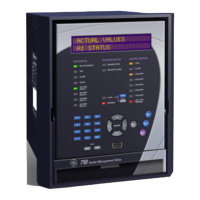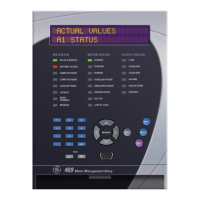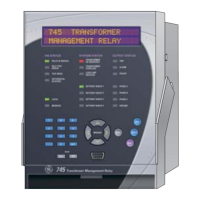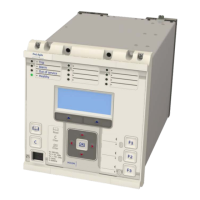GEK - 105560
34
the dangerous ones since people are touching the ground, normally through their footwear and the
floor of the installation.
•
Protection of the relay’s internal circuits against overvoltage.
Overvoltage which can reach the
relay by connections (power supply circuit, output contacts, etc.) tend to be the so-called common
or longitudinal mode; that is, they are overvoltages that try to make the circuit to ground. The filters
in the inside of the relay short-circuit these overvoltages, directing them to ground through the filters
themselves and through grounding.
•
Protection of the relay against electrostatic discharge.
When a person moves towards a relay,
it is possible that he or she is charged in respect to the ground (this is highly improbably in a
substation, but is more likely in an office environment) Upon touching any part of the relay, the
person will produce a discharge to the relay which will make a circuit to the ground until it reaches
the person’s feet. The grounding of the relay will make the discharge travel through the person and
thus avoid its leaving through the interior of the equipment, which could interfere with its normal
operation.
•
Deviation of leakage currents.
In the wiring of any electrical equipment to its case, if the case is
metallic, there is always a capacity, which is the sum of the interference capacity and the capacities
required for filtering. Although the currents that can circulate through these capacities may not be
dangerous for people, they are always startling and annoying, and made worse when the ground is
wet or when lightweight footwear is used.
•
Avoiding spurious measures.
If there are sensitive, high impedance input circuits which are left
disconnected, the leakage currents mentioned in the previous paragraph can make their own
circuits, giving out “ghost” measurements. Grounding keeps the measurement circuits from floating
and the leakage currents from making their own circuits.
A similar case might arise in which the ground, from the perspective of the relay, is more harmful than
beneficial, since the equipment with the better ground will be the one that offers a better path for any
overvoltage produced in the substation. The disturbance could even come from the very ground cable
and make a circuit to a ground with less potential, through the interference capacities with the panels.
In any case, for personal safety the equipment cases must
always
be grounded.
Doubts about the grounding of equipment often arise; not grounding can in some cases be the source
of problems while on the other hand, in other circumstances, unnecessary grounding can also lead to
problems.
When dealing with grounding problems, it is not wise to have set ideas which reduce problems to only
a few possibilities; one must be aware of what problems can arise and why they have come about. The
only set rule, for safety’s sake, should be that all equipment that is meant to be grounded should have
a ground connection.
One of the main reasons for the difficulty in achieving proper grounding is that the equivalent electric
circuit, which is generally a cable, is different according to the frequency of the voltages applied to the
ground. At industrial frequency (50 or 60 Hz), a cable functions as a very low impedance, and therefore
the voltage at the ends will never reach higher values. But as the voltage is increased, the cable will be
more like an inductance, with more impedance, and at higher frequencies the cable functions as a
transmission line. For determined lengths of cable, the situation might arise in which one of the ends
finishes in a short-circuit (which is exactly the goal in grounding), while the same circuit on the other
end is exactly the opposite, that is, an open circuit.
It is helpful to remember that an industrial frequency that undergoes a significant variation in maximum
value, typical in installations in failure circumstances, generates a large amount of high frequency
harmonics.
At industrial frequency it has been seen that the cable presents low impedance, limiting overvoltages in
its ends, but this is at the cost of leading high intensities, which can cause problems in induction or
radiation, to the equipment or to adjacent equipment. This is one of the reasons why loops in the
grounding wires must be avoided.
In conclusion, it is necessary to always keep the recommendations of the manufacturers in mind as far
as safety measures are concerned.
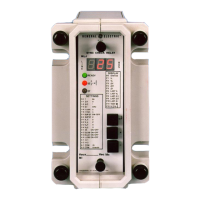
